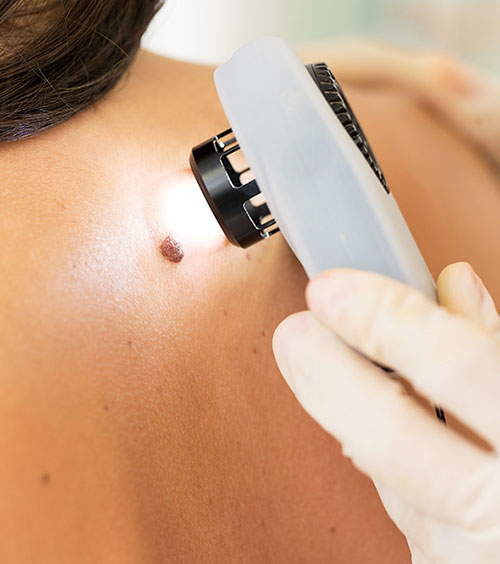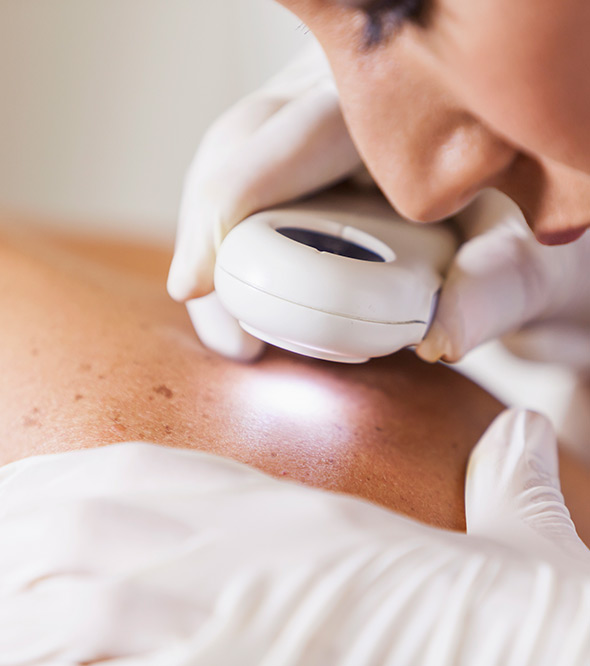Moles, Bumps, and Skin Growth Treatment
As the body ages, it is very common for growths, lumps, bumps, and moles to develop on the skins surface. There are numerous skin conditions that cause these symptoms and many different therapies to treat these conditions ranging from topical ointments and creams to lasers.
Below we will address some of these conditions and the available treatments so that you may know your options and continues to enjoy your great skin!


What are Moles?
A mole is a general term used to describe a growth on the skin. Moles can appear anywhere on the body, either as a single isolated growth, or appear in groups of numerous growths. In children, there harmless growths are sometimes referred to as “beauty marks.” As a person ages, it is common for new moles to develop and for existing moles to slowly change color and become raised. Hair may or may not grow out of a mole.
Moles develop when skin cells cluster together instead of evenly spreading out over the body’s surface. The human body gets its color or pigment from cells called melanocytes. When these cells cluster together, a colored growth appears. Pregnancy and sun exposure can darken the color of a mole. Moles are not dangerous and are generally not a medical concern. One may opt to have moles removed for cosmetic reasons, but as long one does not notice a change in a moles color or shape, there is little reason for concern. A person should be concerned and consult his or her dermatologist immediately if a mole appears different than other growths on the body or if it itches or bleeds. These can be signs of melanoma (the most common form of skin cancer) and can be effectively treated if caught early.
If one opts to have a mole or moles removed for cosmetic reasons, he or she should speak to one of our doctors. There are several treatment options including non surgical laser therapy.
Growths, Lumps, and Bumps
- Skin tags
- Dermatofibroma
- Skin Cysts
- Lipomas


Skin Tags
Numerous benign skin growth (non-cancerous growths) have been documented in medical literature. Skin tags, which are small growths of hanging skin are of the more common benign growths that present on the body. Weight gain and genetics play a role in the development of skin tags which equally affects men and women. Women with larger breasts are prone to developing skin tags under their breasts. Small tags may sometimes rub or fall off without a person knowing it was ever there. Others may remain once formed.
Skin tags do not cause any physical pain or discomfort. One may opt to have them removed for cosmetic reasons, but other than that, there is no need to worry about skin tags. A skin tag may warrant removal if the cells of the tag die causing it to bleed or turn red and black. In other cases, a skin tag may become irritated from continuous snagging on jewelry or clothing causing a person pain and discomfort.
Contact one of our dermatologists for a consultation if you decide to have a skin tag removed. We will assess your situation and inform you of different procedures used to remove skin tags. Several methods for skin tag removal are often employed. These include removing the tag with scissors, freezing the tag with liquid nitrogen, or burning off the tag using medical electric cautery.
Dermatofibroma
Dermatofibroma is a common skin lesion that is benign (non-cancerous). Dermatofibroma present as firm nodules commonly found on the legs and arms and can appear yellow-brown or sometimes pink in color. While majority of dermatofibroma cases develop in young adulthood, it can develop at any age. Studies have shown that females are more susceptible to developing the condition than males. A person may have one or several dermatofibromas. They may develop independently or all at the same time. Dermatofibromas are of little medical concern. For cosmetic reasons one may opt to have a dermatologist remove their dermatofibromas, but as far as health risks are concerned, dermatofibromas are of no risk. If the lesion becomes painful or undergoes a significant change in appearance, one should consult our doctors for a consultation. In some cases, a dark color within a lesion may raise concerns about melanoma.
For those who opt to have their lesion(s) removed for cosmetic reasons, our doctors may recommend a particular treatment option depending on the size, location, and surrounding skin tone. Treatment suggestions may include: reducing the lesion size using liquid nitrogen to freeze the lesion, or a steroid injections into the lesion. Surgical excision can be performed, but one runs the risk of the lesion(s) reoccurring and a cosmetically unappealing scar.


Lipomas
Lipomas are harmless subcutaneous (occur in the deepest layer of skin) tumors or nodules. Lipomas feel soft and fatty and are enclosed by a thin, fibrous capsule. They can appear anywhere on the body, however, they often form on the trunk, shoulders, and neck. A lipoma can develop as an isolated nodule or develop along with several nodules in an isolated location. An average lipoma spans about 5cm in size and presents with minimal symptoms aside from feeling tender to the touch. Lipomas do not infiltrate surrounding tissue and organs and for that reason, there is generally no need to have them removed. One may want a lipoma to be removed for cosmetic reasons or if the mass is causing pain by compressing a surrounding nerve. In such an event, the lipoma may be surgically removed. Of late, liposuction has been used to remove lipomas leaving behind a more cosmetically appealing scar.
General
For the above conditions, our dermatologic surgeons may perform a biopsy, which is covered by most insurances. A biopsy is simply a test where the doctor takes a sample of the infected tissue and sends it to our lab for further examination and to determine whether a disease is present.
